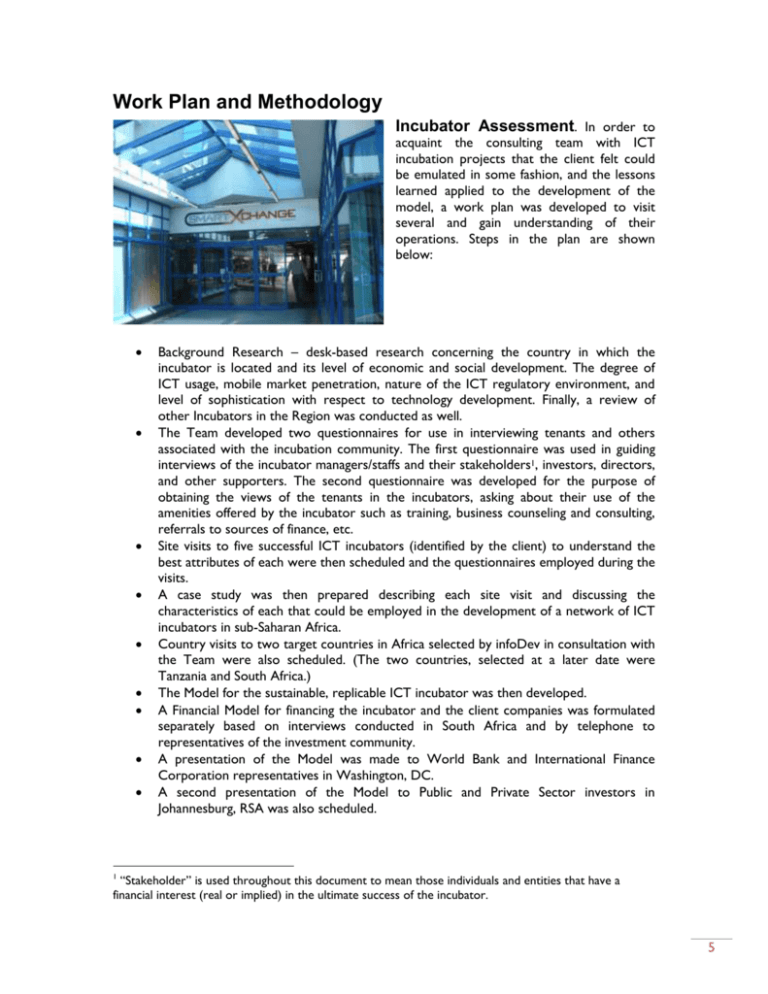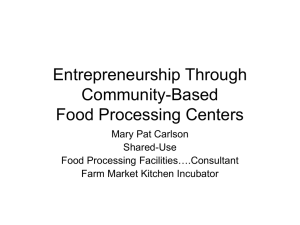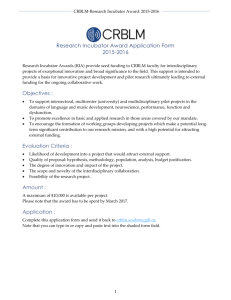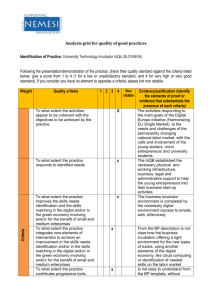Work Plan and Methodology
advertisement

Work Plan and Methodology Incubator Assessment. In order to acquaint the consulting team with ICT incubation projects that the client felt could be emulated in some fashion, and the lessons learned applied to the development of the model, a work plan was developed to visit several and gain understanding of their operations. Steps in the plan are shown below: Background Research – desk-based research concerning the country in which the incubator is located and its level of economic and social development. The degree of ICT usage, mobile market penetration, nature of the ICT regulatory environment, and level of sophistication with respect to technology development. Finally, a review of other Incubators in the Region was conducted as well. The Team developed two questionnaires for use in interviewing tenants and others associated with the incubation community. The first questionnaire was used in guiding interviews of the incubator managers/staffs and their stakeholders1, investors, directors, and other supporters. The second questionnaire was developed for the purpose of obtaining the views of the tenants in the incubators, asking about their use of the amenities offered by the incubator such as training, business counseling and consulting, referrals to sources of finance, etc. Site visits to five successful ICT incubators (identified by the client) to understand the best attributes of each were then scheduled and the questionnaires employed during the visits. A case study was then prepared describing each site visit and discussing the characteristics of each that could be employed in the development of a network of ICT incubators in sub-Saharan Africa. Country visits to two target countries in Africa selected by infoDev in consultation with the Team were also scheduled. (The two countries, selected at a later date were Tanzania and South Africa.) The Model for the sustainable, replicable ICT incubator was then developed. A Financial Model for financing the incubator and the client companies was formulated separately based on interviews conducted in South Africa and by telephone to representatives of the investment community. A presentation of the Model was made to World Bank and International Finance Corporation representatives in Washington, DC. A second presentation of the Model to Public and Private Sector investors in Johannesburg, RSA was also scheduled. 1 “Stakeholder” is used throughout this document to mean those individuals and entities that have a financial interest (real or implied) in the ultimate success of the incubator. 5 Study Design Questions to be Addressed. The following questions were considered in formulating the work plan for this project. The intent was to cover many of the same issue areas as would be investigated in a feasibility study or incubator assessment, so as to understand the issues that confront the managers of the five facilities. They were: • • • • • Does the ICT regulatory environment support private investment? Does tax policy encourage investment in entrepreneurial companies? Is there a strongly committed founder and community support? Is there external support for incubator real estate? How do the client companies sell their services and products? ICT Incubator Visits. The team scheduled visits to the five ICT incubators in various locations around the world were conducted by the IPI Team. The incubators, date of visit, and their locations were as follows: Incubator Visits Incubator Location Dates iPark Jordan Technology Incubator Amman, Jordan 2-5 Sept. Viasphere Yerevan, Armenia 9-12 Sept. ParqueSoft (network) Cali, Colombia (and 6-9 Oct. other locations) SmartXchange Durban, S. Africa 2-5 Nov. Octantis Santiago, Chile 3-7 Nov. Each visit to an ICT incubator provided an opportunity for team members to understand the rationale behind the incubator‟s establishment, its primary sources of funding, the kinds of tenants accepted into the program, the successes experienced and the lessons learned in making the incubator operational. Teams of one or two people were assigned to the respective incubators and visits conducted. Each team was then debriefed on their return, and a visit report was prepared describing the observations made by the tenants and the lessons they believe had merit for inclusion in the report. Analyses of the Site Visit Reports The team analyzed the reports of the site visits with the intent of applying the lessons learned in the development of the visited incubators to a model for Sub-Saharan Africa. These are summarized later in this report. The observations of the incubators were then applied to an organizational design model developed by Behavioral Assessment Associates, a consulting firm that specialized in exactly this type of analysis. Through a series of steps that included an analysis of the Strategic Environment Factors, an Organizational Mission was developed for the ICT 6 incubator. The resulting Mission was then used to determine the Organization Outputs that should be expected, and from that the Standards and Measures of the ICT model. The key point is that the Organization Outputs are directly related to the ICT world, and the Standards and Measures would be unique to the ICT incubators rather than the more general impacts that are typical of any incubation program analysis. Once the organizational model is complete, the Structural Level can be approached and it is in this analysis that the form of organization, work system (means of processing the raw materials and inputs) information flow, and critical measures of the incubator‟s performance are defined. The “critical inputs” that were analyzed were as shown below: Critical Inputs for the ICT Incubator in Sub-Saharan Africa:2 Interviews with individuals involved in incubation across Africa reinforce the conclusion that, although ICT is universally recognized as a means of rapid economic development, differences in business culture and approach to developing ICT business vary considerably. Development of ICT incubators in widely disparate locations must take this into account. In addition, the various elements of the business environment that each incubator will operate in must be considered. Below is a list of those elements of the environment felt to impact development of ICT businesses (and ICT incubators). 1. Technological Forces – emergence of trends, devices, events that influence, etc. Includes elements such as Internet bandwidth and telecom access, growth of mobile phone access and services. 2. Legal & Regulatory Forces – laws governing ICT; national tax systems with respect to investment; regulatory environment; deregulation and liberalization of fixed line and wireless; trend toward a free market view of business. 3. Economic Factors – high unemployment; limited access to social services; impact of industry (agriculture, extraction, tourism, medical services) use of microfinance; and trend toward collaboration between businesses. 4. Political Forces – dynamic political environment that varies by location. 5. Social & Demographic Factors – high birthrates in many countries; much of the population at or below poverty level; low life expectancy; support for free markets. 6. Raw materials & Resources required (processed by the organization to accomplish its mission) – trained labor force; equipment for access to networks, test equipment, etc. 7. Competitive Entities and Forces – displacement of fixed-line services by mobile services. 8. Stakeholders (and how they construe their mission) – Includes banks; large companies; academia; equipment and service providers. 9. Other Organizational Factors – need for a professional network of incubators (e.g., African Incubation Network – AIN – and others) requirements of training programs for entrepreneurs (and incubator managers); governance issues (e.g., board structure and roles). The factors listed above were considered by the team, and then used to develop the generic ICT Incubator Mission and the outputs (products) of the incubator. 2 The format for this systems analysis was originally developed by Behavioral Assessment Associates, Morris Plains, NJ, (Dr. Ross‟ former consultancy). 7 Mission of the ICT Incubator in Sub-Saharan Africa Provide a safe, stable and secure place to start and grow companies that can offer needed services, support and equipment to the ICT community within the country and the region. Create employment in both ICT and the larger business community. Promote development of a free market system through training and education, making use of entrepreneurial talent to improve the community‟s economic well being. Enable access to equipment and services required by the new companies. Be a focal point of entrepreneurial activity, networking between tenant companies, the business community and potential partners. Organizational Outputs of the ICT Incubator in Sub-Saharan Africa The ICT Incubator in Sub-Saharan Africa will produce organizational outputs. They are derived from the Mission Statement above: 1. Tenants of the incubator will deliver ICT services and products throughout the country and the region. 2. Tenant companies will create employment for individuals in the country and the region. 3. Incubator training will contribute to enhancement of a skilled ICT labor force throughout the country and the region. 4. Tenant companies will sell value-added services and products. 5. The ICT companies that graduate will be sustainable. In this model, the outputs of the incubator must be tangible, and used as inputs to another process. That would mean that the graduate companies, the services and products they sell (or re-sell) and jobs created as a result would all qualify as outputs. Graduation is a primary objective in most developed country incubation programs. However, in virtually all of the incubators visited by the study team, graduation is frequently not a primary objective of the program. In addition, the kinds of coaching, mentoring and counseling services typical of an incubator program may be unavailable or less reliable outside the incubator. Client company entrepreneurs may also find that the incubator‟s internal network which served them while they were clients is no longer available once they graduate and it can make the decision to leave the facility a difficult one. Without some incentive from the management to move on, some companies can become permanent residents. The problem becomes more acute if the rents are kept artificially low, or there is no logical next step in the incubation process such as the ability to find “graduate” space outside the incubator. Standards and Measures In order to determine if the incubator has achieved its mission, a means of measuring its success is required. Typically this is done by describing some standards of economic impact for the incubator‟s operations. Quantitative measurement gives an indicator that can be compared across the board, taking into account the differences in operating environments that will be faced by a constellation of ICT incubators across Africa. 8 The following appear to be reasonable measures of success given the environment, Mission Statement, and Outputs stated above. These measures might be most useful for infoDev and IFC monitoring of the group of incubators. Employment creation – the numbers of full- and part-time jobs created by the client companies in the incubator. While job creation can be misleading in that the intent of encouraging ICT development is to create jobs above the subsistence level, it is the most common measure of incubator success in other parts of the world. Numbers of client company contracts (new and existing) – this measure would give an indication of the true business activity of the individual companies. Year-on-Year growth of Revenues – a percentage improvement illustrating growth in company revenues. Numbers of “walk-through” employees – those who were trained but did not stay with the client company should be reported in addition to current employees as they are still trained ICT workers presumably available for employment in the industry. Aggregate client company growth in turnover – the aggregate amount for all companies in the incubator should preclude client company reluctance to reveal economic performance. Post-Graduation, Year-on-Year Annual Turnover Growth – more than in other environments, sustainable, replicable ICT incubators in Africa will require some path forward for those companies that grow to a point requiring graduation or which seek graduation for other reasons. Their progress must be tracked in order to develop the level of public support that will be required to sustain the program. The Team summarized their incubator case studies for inclusion in the body of this report. Summary of Incubator Attributes Five incubators were visited during the period September through November of 2008. The important characteristics that make each of these incubators attractive as contributors to the Africa ICT model are shown below. The methodology for examining the incubators was to visit for a three to four day period, during which time the management, and a selection of stakeholders and sponsors; advisors; and tenants were interviewed in depth to obtain their views concerning the attributes of their operations that made their programs successful. (A list of interview participants appears at the end of each case study report.) Each of the incubators is discussed briefly below with an emphasis on the factors that led to its success. 9





